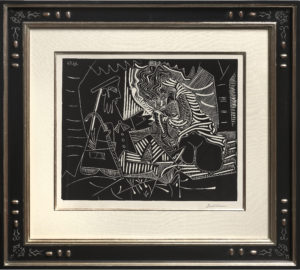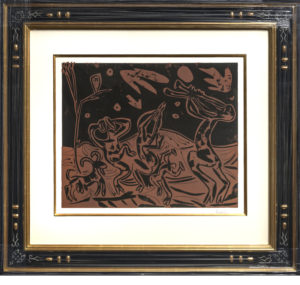Huth, Boeing I, and Salmon Galleries
July 15 – October 15, 2023

Pablo Picasso, Tête de Femme au Chapeau, 1962, color linocut on Arches watermarked paper, 13 3/4 x 10 5/8 inches, 34 x 30 inches framed. Image courtesy of Landau Traveling Exhibitions, Los Angeles, CA.
Lecture & Reception with Megan Fontanella, Curator, Modern Art and Provenance
at the Solomon R. Guggenheim Museum, New York
and Dr. Timothy Collins
Young Picasso in Paris
Tuesday, July 18 | 6 – 8 p.m.
A Graphic Journey: Prints by Pablo Picasso from the Dr. Timothy Collins Collection marks the 50th anniversary of Picasso’s death and celebrates the unparalleled significance the artist had on modern and contemporary art. The exhibition presents an insightful gathering of approximately 60 etchings, lithographs and linocuts by one of the great masters of the 20th Century, Pablo Picasso. It provides a unique window into a significant era in art history and takes a serious look at the artist’s development and creative process. Best known for his paintings and sculptures, Picasso was also a major innovator in the medium of printmaking. He made prints throughout his career — his first in 1899, when he was still a teenager, and his last in 1972, when he was 90 years old.
The exhibition illustrates the three major phases of Picasso’s printmaking career, as well as his signature artistic themes. A special feature of this collection is the number of proofs it contains. These proofs illustrate the unique working relationship Picasso maintained with his printers and their workshops, and allow for close examination of the working process behind it. Organized by Landau Traveling Exhibitions, Los Angeles, CA.
“Pablo Picasso is considered the most pivotal, innovative artist of the 20th century, displaying the evolutionary process of his creative genius both artistically and technically. He challenged all his artistic mediums to attain the optimum results for his art. Picasso had a true passion for printmaking and, because of it, became a major innovator in the medium of printmaking. He altered his methods to achieve singular expressive qualities in his multiples. His proofs illustrate the unique working relationship Picasso maintained with his printers and the ateliers. Their craftsmanship made Picasso’s extensive and revolutionary experimentation with the media possible. Works created in collaboration with the great printers represent the breadth of Picasso’s considerable oeuvre in linocuts, etchings, and lithography and allow us to examine the working process behind it. The exhibition provides an extraordinary opportunity to see the creative magic and originality of Picasso’s hand.” – Dr. Timothy Collins

Pablo Picasso, Variation Sur Le Dejueuner Sur L’Herbe de Manet, 1961, linoleum cut, 20¼ by 25½ inches, 39 x 40 inches framed. Image courtesy of Landau Traveling Exhibitions, Los Angeles, CA.

Pablo Picasso, Danse Nocturne avec un Hibou, 1959, linoleum cut printed in black and brown, 21 by 25¾ inches, 42 x 39 1/2 inches framed. Image courtesy of Landau Traveling Exhibitions, Los Angeles, CA.
About the Speaker:

Photograph by Don Hamerman
Megan Fontanella is Curator, Modern Art and Provenance, at the Solomon R. Guggenheim Museum, New York. Her research encompasses late nineteenth- through mid-twentieth-century European and U.S. avant-gardes, with a particular focus on dealer networks and collecting patterns. Since joining the institution in 2005, Fontanella has curated or co-organized over thirty exhibitions for the Guggenheim’s constellation of museums in Bilbao, New York, Venice, and formerly Berlin, as well as developed shows abroad for the traveling exhibitions program.
To mark the opening of the exhibition A Graphic Journey: Prints by Pablo Picasso at the Huntsville Museum of Art, Guggenheim curator Megan Fontanella examines the artist’s initial forays into Paris as a young man and the impact of the contemporary subjects and styles he encountered there. Pablo Picasso (b. 1881, Málaga, Spain; d. 1973, Mougins, France) arrived in the city of light from Barcelona in autumn 1900, during the final weeks of the Exposition Universelle. Though the nineteen-year-old Spaniard spoke little French, he absorbed everything Paris had to offer over his initial two-month stay, and again after his return to the capital the following spring through the end of 1901. Picasso patronized not only the art galleries, but also the bohemian cafés, raucous nightclubs, and sensational dance halls that permeated his hilltop neighborhood of Montmartre. Le Moulin de la Galette (ca. November 1900), one of the artist’s first paintings in Paris and recently the subject of a conservation research and treatment project at the Guggenheim, is a highlight from this pivotal juncture in the artist’s development. Picasso’s early work presages the social disenfranchisement that he brought into sharper relief in his subsequent Blue Period (1901–04) through his depictions of the exploited and vulnerable. On the precipice in 1900, Picasso eventually crafted a singular practice reflective of his time.
Thank you, Sponsors!
Presenting Sponsor:

Champion Sponsor:
The Jurenko Foundation
Gold Sponsors:
Sally and Bob Arthur
The Broadway Group
Connie and Rusty Stephenson

President’s Circle Sponsors:
Parker Griffith Family Foundation
Patsy and John Shields
Artist’s Circle Sponsors:
Jean and Jerre Penney
The Huntsville Museum of Art is grateful to the
Huntsville/Madison County Convention & Visitors Bureau
for their support in promoting this exhibit.
Huntsville.org


